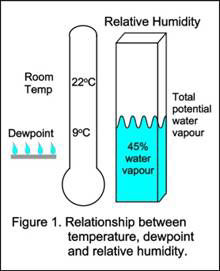
Taking Warnings About High Humidity in Your Data Centre With a Pinch of Salt?
In its pure crystalline form, salt is harmless, even when it is sitting on a circuit board inside a server. Salt crystals can remain in place for years without causing any problems. However, if a critical threshold of moisture is reached in the environment, the resulting saline solution is able to promote corrosion and to conduct electricity.
If your data centre is using free cooling and within ten kilometres of a coast (ASHRAE - 2011 Gaseous and Particulate Contamination Guidelines For Data Centers) or near salted roads, or if it is using evaporative cooling or ultrasonic humidification, then it is highly likely that at some time, salt crystals have taken up residence.
Relative Humidity (RH) is the amount of water in the air, compared with the total amount of water the air can possibly hold at a given temperature. Dewpoint is the temperature at which moisture leaves the vapour phase and condenses on a cooled surface. Dewpoint varies with both humidity and temperature. The higher the temperature, the more moisture the air can hold. At lower temperatures, water vapour condenses out of the air and settles on a surface more readily. Although the ASHRAE guidelines (ASHRAE - 2011 Thermal Guidelines for Data Processing Environments) support a wider range of temperature and relative humidity, (for example Class A2, Temp: 10-35 Deg. C, RH:8-80%), they also specify that all metrics should result in an environment that is 'non-condensing', that is, that the dewpoint is never reached.

While dewpoint is a good indicator of condensation on clean surfaces, on contaminated surfaces the deliquescent relative humidity of the contaminating material takes control, and moisture can be absorbed onto the surface well before the dewpoint temperature is reached.
Inside the data centre, water aerosol droplets are formed during evaporative cooling or ultrasonic humidification processes. Water aerosol droplets containing impurities can also enter a data centre along with the fresh air.
Once present, droplets begin to evaporate. This process (1) adds molecular water to the atmosphere, increasing the room's absolute humidity and (2) reduces a droplet's size, thereby increasing the concentration of the compounds dissolved within it. The less soluble compounds (typically containing hard water components such as magnesium and calcium) are the first to drop out of solution.
The more soluble components are transported farther, until the carrier (water) becomes so saturated that it can no longer retain these components (such as salt). Once a droplet reaches a warmer environment such as a server, the heat encourages the final evaporation and deposit of solids.
Even where additional purification, such as reverse osmosis (RO), is applied to the water used in ultrasonic humidification or evaporative cooling processes, the same chemical compounds are still present, albeit at far lower concentrations. Accumulation still occurs, but at a slower rate.
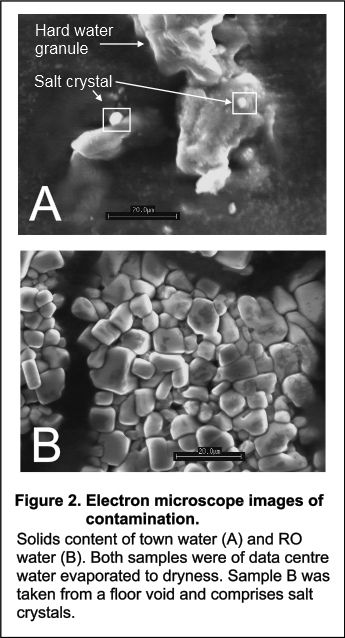
At high relative humidity, a salt crystal starts interacting with molecular water in the air. Once in solution, the salt molecule separates into positive sodium (cation) and negative chlorine (anions) ions. The separated ions are driven by circuit potentials, and so move through a solution, conducting a current that can leak away high frequency voltage signals to a point where the signals can no longer be discriminated.
In the presence of chloride ions, iron converts to iron oxide (rust). The chloride ions are never ‘consumed’ in this process, so a little salt can go a very long way in causing iron corrosion. Metals present in computer construction, such as iron, tin, nickel and copper, all may undergo a corrosive reaction. For example, free chloride ions help form copper chloride. Interestingly, copper chloride (copper creep) itself has a deliquescent relative humidity (ASHRAE - 2011 Gaseous and Particulate Contamination Guidelines For Data Centers) so, if present, requires an even lower humidity to propagate a corrosion process.
An additional complicating factor is the removal of lead from solder. (Restriction of Hazardous Substances Directive 2002/95/EC, RoHS 1, 2003.) The lead component created an unreactive, passive film on the surface of tin-lead solder but now, with no lead present, the surface is far less protected.
Adhering to the more permissible ASHRAE Class 2 guidelines will increase the variability of microclimates throughout the room. Relative humidity metrics are only snapshots of the room conditions at a few points in the room, most likely at an air handler, and will not fully reflect conditions at all points in the room. A fresh blast of cool, outside air on a rainy day can hit the front of a server at a high relative humidity and exit the back of the server at a far lower value. Any salt deposited in the server will attract water and form a solution. The damaging process begins, and yet the humidity meter, depending on its location, would still return a reading that was well within the Class 2 guidelines.
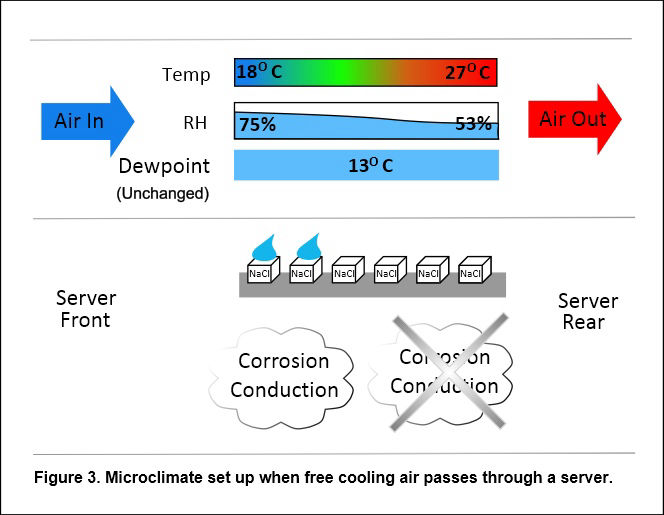
Diagnosis may be difficult. Breakdowns can occur then disappear, as room ambient conditions vary. A component that failed due to aberrant, salt-solution-induced conduction may function normally under subsequent drier conditions and show no functional defect when tested in its manufacturer's lab, under standard conditions. Circuit cards can sometimes display visible corrosion in the region of the card that is most exposed to cooler, humid air.
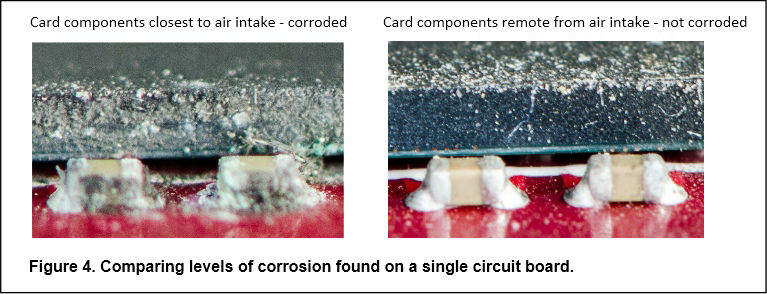
If your data centre has the potential for salt infiltration, then you may want to watch temperature and humidity over an extended period of time and at relevant significant locations such as at close to servers. Matching this data with outside climatic conditions will help establish how the internal environment is affected by the external environment, and inform when additional humidity control measures are required.
The presence of salt and of corrosion products can be confirmed by taking samples from a room and analysing them using X-ray elemental analysis (EDX) in a scanning electron microscope (SEM). However, this piece of knowledge provides only part of the picture. If salt is present in your data centre, it still requires elevated humidity levels to cause problems.
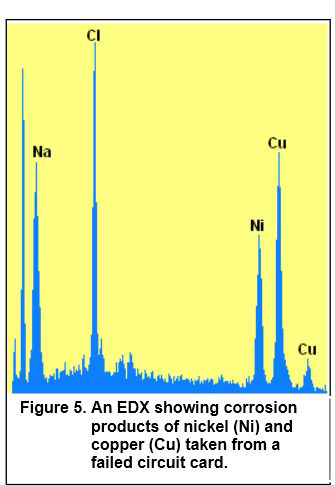
If contaminants such as salt are likely to be present, it is more important than ever to adhere to ASHRAE's stricter Recommended range (maximum 60% RH and Dewpoint 15 Deg. C.). This range provides a strong buffer against conditions that could lead to the formation of a saline solution. The less restrictive Class A1 and Class A2 allowances cannot guarantee a condensation-free, reliable IT environment if salt is present.